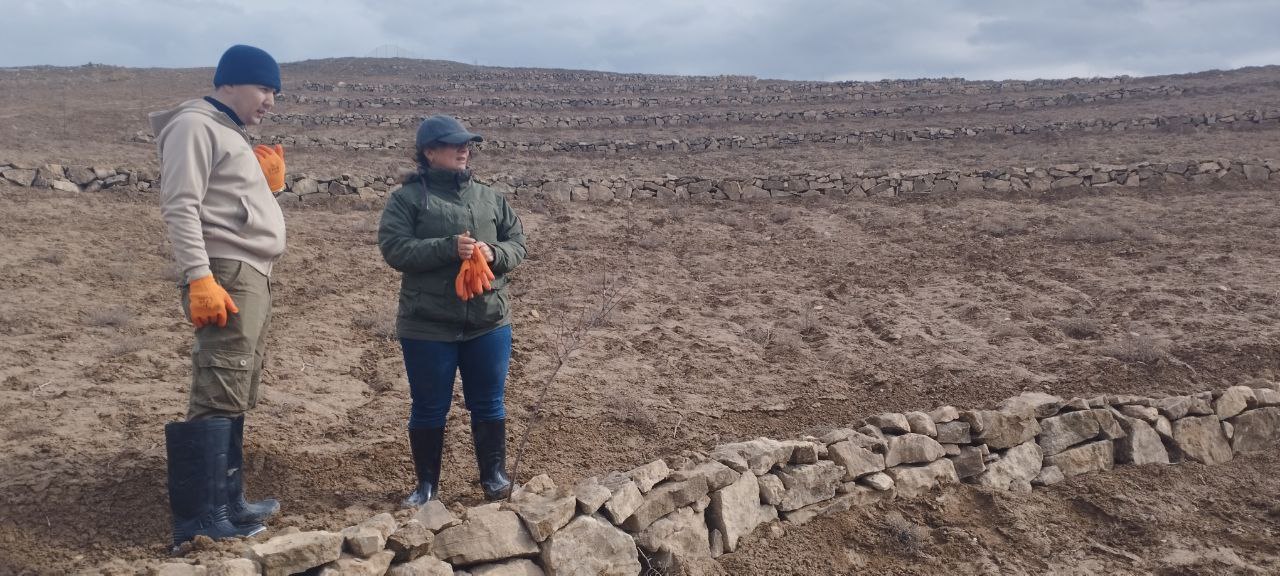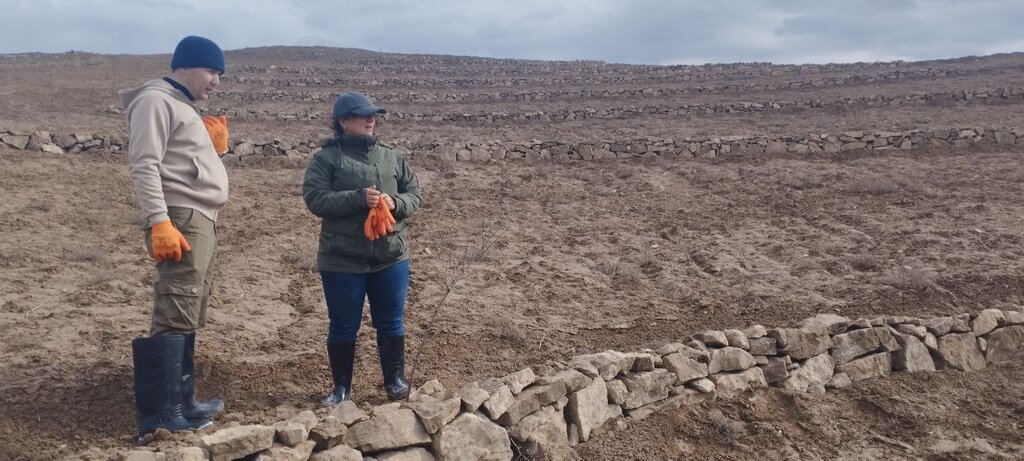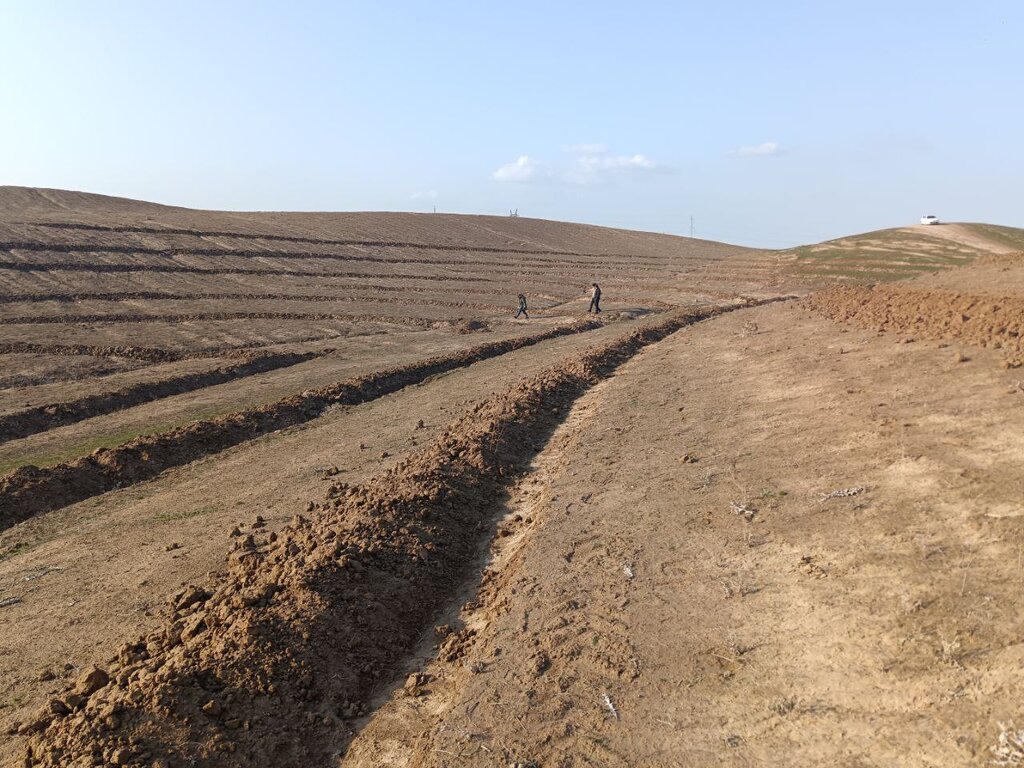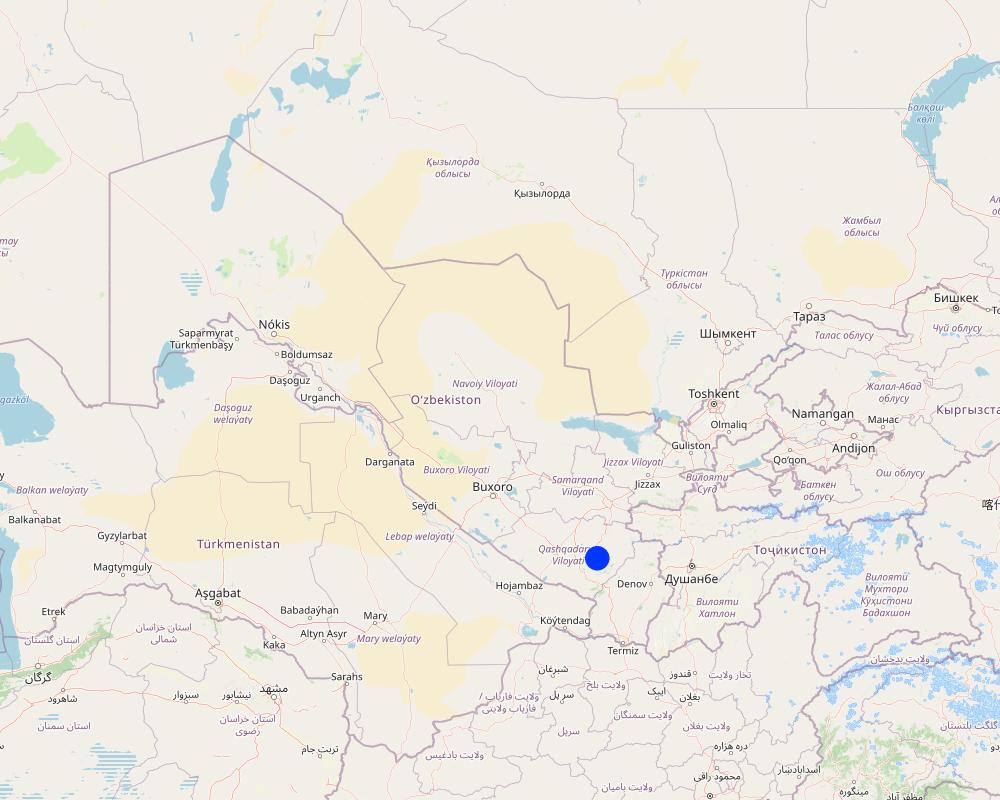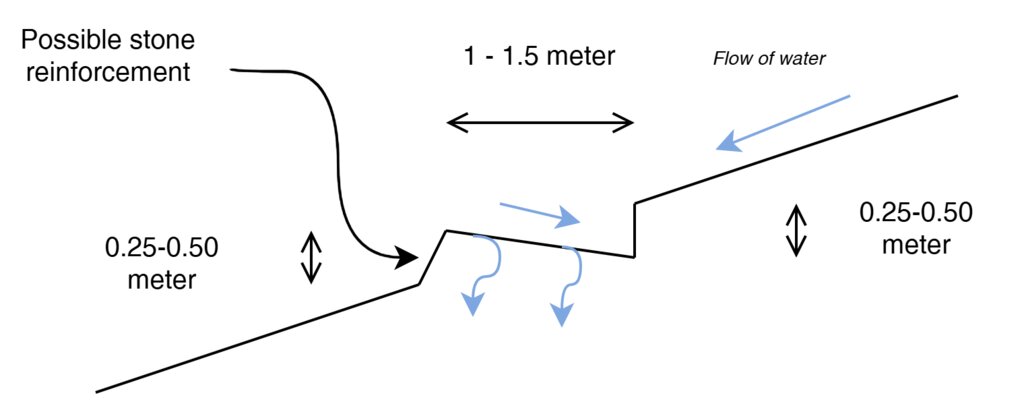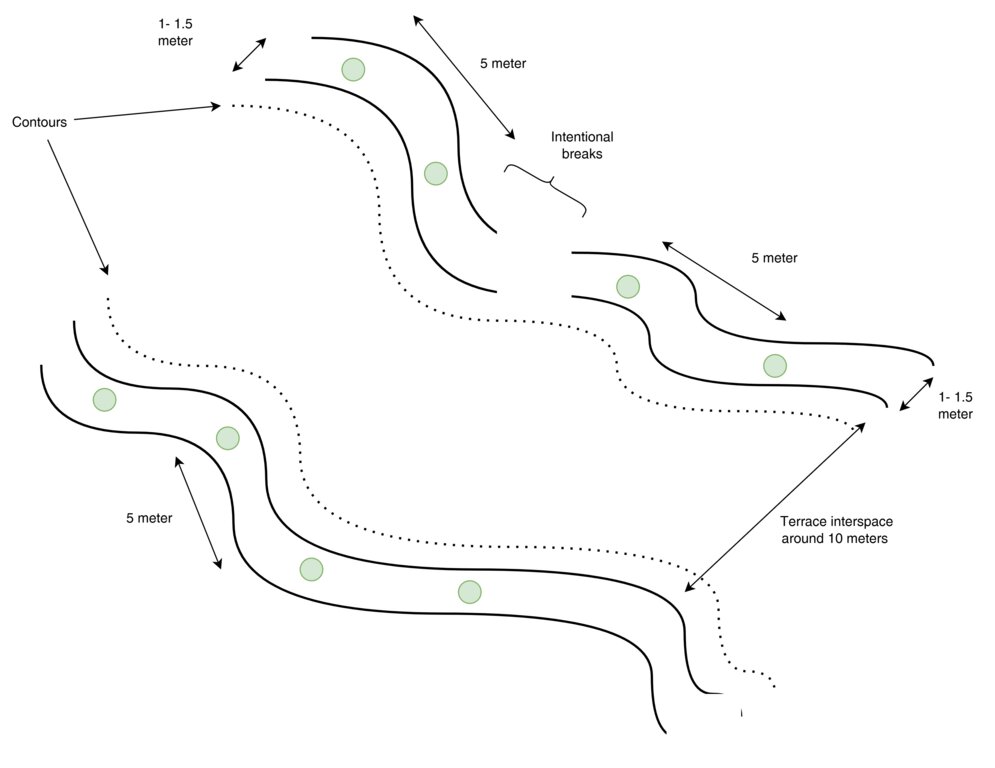Gradoni Orchard Terraces [乌兹别克斯坦]
- 创建:
- 更新:
- 编制者: Joren Verbist
- 编辑者: Hayot Ibrakhimov
- 审查者: William Critchley, Rima Mekdaschi Studer
technologies_7553 - 乌兹别克斯坦
查看章节
全部展开 全部收起1. 一般信息
1.2 参与该技术评估和文件编制的资源人员和机构的联系方式
Senior Scientist Sustainable Land Management:
Akramkhanov Akmal
International Center of Agriculture Research in the Dry Areas (ICARDA)
乌兹别克斯坦
Crop Specialist:
Fayzullayev Abdulla
International Center of Agriculture Research in the Dry Areas (ICARDA)
乌兹别克斯坦
Water Harvesting Expert:
Ali Muddaber Mohammad
International Center of Agriculture Research in the Dry Areas (ICARDA)
约旦
Water Harvesting Expert:
Alwidyan Jafar
International Center of Agriculture Research in the Dry Areas (ICARDA)
约旦
Project Manager:
Nurbekov Aziz
Food and Agriculture Organization (FAO) of the United Nations
乌兹别克斯坦
有助于对技术进行记录/评估的项目名称(如相关)
ICARDA Institutional Knowledge Management Initiative有助于对技术进行记录/评估的项目名称(如相关)
Food Systems, Land Use, and Restoration Impact Program in Uzbekistan (GCP/UZB/010/GFF) (FOLUR)有助于对技术进行记录/评估的机构名称(如相关)
ICARDA International Center for Agricultural Research in the Dry Areas (ICARDA) - 阿拉伯叙利亚共和国1.3 关于使用通过WOCAT记录的数据的条件
编制者和关键资源人员接受有关使用通过WOCAT记录数据的条件。:
是
1.4 所述技术的可持续性声明
这里所描述的技术在土地退化方面是否存在问题,导致无法被认为是一种可持续的土地管理技术?:
否
2. SLM技术的说明
2.1 技术简介
技术定义:
Gradoni orchard terraces are intermittent strips of contour-based structures separated by catchments of about 10 metres. They are designed to capture and hold rainwater, reduce erosion, and improve conditions for the cultivation (in this case) of almond and pistachio trees, thereby enhancing land productivity and climate resilience in dryland areas.
2.2 技术的详细说明
说明:
Qashqadaryo Province in southern Uzbekistan experiences a hot, dry summer and a mild winter. Combined with unsustainable land management practices, climatic stresses have exacerbated land degradation and made local livelihoods increasingly vulnerable.
As part of the Food Systems, Land Use and Restoration (FOLUR) project, the International Center for Agricultural Research in the Dry Areas (ICARDA) designed and tested rainwater harvesting (RWH) structures to combat land degradation and enhance rural livelihoods. These RWH structures support vegetation growth, reduce surface runoff, prevent erosion, and restore soil health—thereby reversing degradation and improving agricultural productivity.
The intervention site, covering approximately 1.6 hectares, is characterized by shallow clay soils (5–25 cm deep).
Gradoni orchard terraces (“intermittent terraces” or “step terraces”) were used. These small contour-based earth structures are separated by catchments of about 10 metres. They are designed to capture and hold rainwater, reduce erosion, and improve conditions for the cultivation – in this case of almond and pistachio.
Two variations were implemented depending on the slope gradient: one with stone-reinforced risers on steep slopes (20–25%), and the other with earth risers on moderate slopes (12–19%). The terraces are sited about 10 meters apart on contour lines, and the terrace beds are only 1-1.5 metres wide and the risers 0.25-0.5 metres high. Along each back-sloping terrace bed, 5 metres spacing between trees was considered optimal.
Following site assessment, data collection, and detailed design calculations, implementation commenced. Although a grader was initially preferred for terrace construction, an older local tractor was used due to its better manoeuvrability on the steep terrain. The tractor ploughed the land using a two-mouldboard plough, after which manual labour, guided by technical experts, shaped the terraces. To accommodate natural contour variability, the terraces were not continuous – but gaps were left between them.
During a week of implementation, 25 Gradoni terraces were constructed, of which eight were stone-reinforced. Around 340 almond and pistachio trees were planted. Two workers had spent two days marking contour lines, while ten others worked for four days to finalize the terraces after the tractor had loosened the soil. The estimated lifespan of the terraces is around 20 years without maintenance, with the stone-reinforced ones expected to last even longer.
Land users expressed optimism about the prospect of improved incomes from almond and pistachio yields, especially considering the previously low or non-existent production due to severe land degradation and lack of water.
Maintenance requirements are expected to be minimal. Experts highlighted the terraces' role in capturing and retaining rainwater, which supports vegetation regeneration and contributes significantly to reversing and preventing further land degradation. By improving water availability, the intervention strengthens the community’s ability to withstand droughts, thereby securing income in the face of climate variability. The introduction of pistachio and almond cultivation provides a new and valuable source of income for local land users. These tree crops are well-suited to the arid environment and are inherently drought-resilient, making them an ideal choice for sustaining agricultural productivity under increasingly dry conditions.
Acknowledgement: This SLM was introduced by ICARDA in the framework of Food Systems, Land Use and Restoration Impact Program (FOLUR) in Uzbekistan (GCP/UZB/010/GFF), implemented by FAO with funding from the Global Environment Facility (GEF)
2.3 技术照片
2.5 已应用该技术的、本评估所涵盖的国家/地区/地点
国家:
乌兹别克斯坦
区域/州/省:
Qashakadarya province
有关地点的进一步说明:
8°43'14.26"N, 66°41'51.87"E
具体说明该技术的分布:
- 均匀地分布在一个区域
如果不知道精确的区域,请注明大致覆盖的区域:
- < 0.1 平方千米(10 公顷)
技术现场是否位于永久保护区?:
否
Map
×2.6 实施日期
注明实施年份:
2024
2.7 技术介绍
详细说明该技术是如何引入的:
- 通过项目/外部干预
3. SLM技术的分类
3.1 该技术的主要目的
- 改良生产
- 减少、预防、恢复土地退化
- 适应气候变化/极端天气及其影响
- 创造有益的经济影响
- 创造有益的社会影响
3.2 应用该技术的当前土地利用类型
同一土地单元内混合使用的土地::
否

农田
- 乔木与灌木的种植
- Almond and Pistachio nut trees
注释:
There are ideas to include some crop production/cultivation between the terraces. To enhance production as well as soil conservation.
3.3 由于技术的实施,土地使用是否发生了变化?
由于技术的实施,土地使用是否发生了变化?:
- 是(请在技术实施前填写以下有关土地利用的问题)

牧场
粗放式放牧:
- 半游牧畜牧业
- Mixed
3.4 供水
该技术所应用土地的供水:
- 雨养
3.5 该技术所属的SLM组
- 改良的地面/植被覆盖
- 横坡措施
- 集水
3.6 包含该技术的可持续土地管理措施

农艺措施
- A1:植被和土壤覆盖层
- A3:土壤表面处理
- A4:地表下处理

植物措施
- V1:乔木和灌木覆盖层

结构措施
- S1:阶地
- S2:堤、岸
- S3:分级沟渠、渠道、水道
- S7:集水/供水/灌溉设备

管理措施
- M1:改变土地使用类型
- M2:改变管理/强度级别
3.7 该技术强调的主要土地退化类型

土壤水蚀
- Wt:表土流失/地表侵蚀
- Wg:冲沟侵蚀/沟蚀
- Wo:场外劣化效应

土壤风蚀
- Et:表土流失
- Ed:风蚀风积
- Eo:场外劣化效应

物理性土壤退化
3.8 防止、减少或恢复土地退化
具体数量名该技术与土地退化有关的目标:
- 减少土地退化
- 修复/恢复严重退化的土地
4. 技术规范、实施活动、投入和成本
4.1 该技术的技术图纸
技术规范(与技术图纸相关):
The Gradoni terraces are step-like structures constructed along contour lines on sloping terrain to reduce runoff, capture rainwater, and support vegetation growth. Each terrace has a horizontal width of approximately 1.0 to 1.5 meters, and is built by cutting and filling the slope to form a level planting surface and water retention/infiltration area.
The vertical cut and fill height is typically 0.25 to 0.50 meters, depending on site conditions. On steeper slopes (20–25%), the terrace face is reinforced with stones to enhance structural stability and longevity. On moderate slopes (12–19%), no stone reinforcement is required.
Annual precipitation is 200mm and plants require around 400mm.
作者:
ICARDA
日期:
2025
技术规范(与技术图纸相关):
This top view illustrates the layout of Gradoni terraces constructed along contour lines on sloped terrain. The terraces follow the natural contours of the land to minimize runoff and maximize water retention, with dotted lines representing the contour guides used during marking.
Each terrace is approximately 1.0 to 1.5 meters wide, with around 10 meters of vertical spacing between terraces (terrace interspace). Pistachio and almond trees, selected for their drought resilience and economic value, are planted at regular 5-meter intervals along the terraces.
The drawing also includes intentional breaks in some of the terrace segments. These breaks are a precautionary measure to reduce the risk of structural damage in cases where the contour is not perfectly followed or alignment is imperfect. By interrupting the continuity, they help dissipate excess water flow and prevent erosion or collapse of terrace edges on uneven terrain.
作者:
ICARDA
日期:
2025
4.2 有关投入和成本计算的一般信息
具体说明成本和投入是如何计算的:
- 每个技术区域
注明尺寸和面积单位:
1.6 ha
具体说明成本计算所用货币:
- 美元
4.3 技术建立活动
| 活动 | 时间(季度) | |
|---|---|---|
| 1. | Start of field activities: Site setup, contour line marking by 2 workers | 20 September |
| 2. | Continuation of contour marking | 21 September |
| 3. | Tractor plowing using a chain tractor with 2-moldboard plow | 22 September |
| 4. | Manual terrace formation by 10 laborers; shaping and adjusting terraces | 23–26 September |
| 5. | Tree planting – approximately 340 pistachio and almond trees planted | 25–26 September |
4.4 技术建立所需要的费用和投入
| 对投入进行具体说明 | 单位 | 数量 | 单位成本 | 每项投入的总成本 | 土地使用者承担的成本% | |
|---|---|---|---|---|---|---|
| 劳动力 | Contour marking | Person-days | 4.0 | |||
| 劳动力 | Terrace shaping | Person-days | 40.0 | |||
| 劳动力 | Stone reinforcement | Person-days | 8.0 | |||
| 劳动力 | Tree planting | Person-days | 8.0 | |||
| 劳动力 | Supervision | Person-days | 5.0 | |||
| 设备 | Tractor + plough/grader | Machine-Days | 2.0 | |||
| 植物材料 | Seedlings | Number | 340.0 | |||
| 肥料和杀菌剂 | Manure | kg | 1350.0 | |||
| 施工材料 | Stones | m3 | 120.0 | |||
| 其它 | total cost | 1.0 | 3200.0 | 3200.0 | ||
| 技术建立所需总成本 | 3200.0 | |||||
| 技术建立总成本,美元 | 3200.0 | |||||
如果您无法分解上表中的成本,请估算建立该技术所需要的总成本。:
3300.0
如果土地使用者负担的费用少于100%,请注明由谁负担其余费用:
Project
4.5 维护/经常性活动
| 活动 | 时间/频率 | |
|---|---|---|
| 1. | Inspections and incidental repairs | Throughout year |
4.6 维护/经常性活动所需要的费用和投入(每年)
| 对投入进行具体说明 | 单位 | 数量 | 单位成本 | 每项投入的总成本 | 土地使用者承担的成本% | |
|---|---|---|---|---|---|---|
| 劳动力 | Inspection and incidental repairs | person-days | 2.0 | 100.0 |
注释:
It is not quantified and evidenced but 10-25% of establishment is typically considered the yearly cost of maintenance.
5. 自然和人文环境
5.1 气候
年降雨量
- < 250毫米
- 251-500毫米
- 501-750毫米
- 751-1,000毫米
- 1,001-1,500毫米
- 1,501-2,000毫米
- 2,001-3,000毫米
- 3,001-4,000毫米
- > 4,000毫米
农业气候带
- 半干旱
5.2 地形
平均坡度:
- 水平(0-2%)
- 缓降(3-5%)
- 平缓(6-10%)
- 滚坡(11-15%)
- 崎岖(16-30%)
- 陡峭(31-60%)
- 非常陡峭(>60%)
地形:
- 高原/平原
- 山脊
- 山坡
- 山地斜坡
- 麓坡
- 谷底
垂直分布带:
- 0-100 m a.s.l.
- 101-500 m a.s.l.
- 501-1,000 m a.s.l.
- 1,001-1,500 m a.s.l.
- 1,501-2,000 m a.s.l.
- 2,001-2,500 m a.s.l.
- 2,501-3,000 m a.s.l.
- 3,001-4,000 m a.s.l.
- > 4,000 m a.s.l.
说明该技术是否专门应用于:
- 不相关
5.3 土壤
平均土层深度:
- 非常浅(0-20厘米)
- 浅(21-50厘米)
- 中等深度(51-80厘米)
- 深(81-120厘米)
- 非常深(> 120厘米)
土壤质地(表土):
- 中粒(壤土、粉土)
土壤质地(地表以下> 20厘米):
- 中粒(壤土、粉土)
- 细粒/重质(粘土)
表土有机质:
- 中(1-3%)
5.4 水资源可用性和质量
地下水位表:
5-50米
地表水的可用性:
匮乏/没有
水质(未处理):
仅供农业使用(灌溉)
水质请参考::
地下水和地表水
水的盐度有问题吗?:
否
该区域正在发生洪水吗?:
是
规律性:
偶然
5.5 生物多样性
物种多样性:
- 低
栖息地多样性:
- 低
5.6 应用该技术的土地使用者的特征
定栖或游牧:
- 定栖的
生产系统的市场定位:
- 混合(生计/商业)
非农收入:
- 收入的10-50%
相对财富水平:
- 非常贫瘠
- 贫瘠
个人或集体:
- 个人/家庭
- 员工(公司、政府)
机械化水平:
- 手工作业
- 机械化/电动
性别:
- 女人
- 男人
土地使用者的年龄:
- 儿童
- 中年人
说明土地使用者的其他有关特征:
The farmer using the land is an employee at the forestry department.
5.7 应用该技术的土地使用者使用的平均土地面积
- < 0.5 公顷
- 0.5-1 公顷
- 1-2 公顷
- 2-5公顷
- 5-15公顷
- 15-50公顷
- 50-100公顷
- 100-500公顷
- 500-1,000公顷
- 1,000-10,000公顷
- > 10,000公顷
这被认为是小规模、中规模还是大规模的(参照当地实际情况)?:
- 小规模的
5.8 土地所有权、土地使用权和水使用权
土地所有权:
- 州
- 个人,有命名
土地使用权:
- 个人
- Water not available
土地使用权是否基于传统的法律制度?:
是
5.9 进入服务和基础设施的通道
健康:
- 贫瘠
- 适度的
- 好
教育:
- 贫瘠
- 适度的
- 好
技术援助:
- 贫瘠
- 适度的
- 好
就业(例如非农):
- 贫瘠
- 适度的
- 好
市场:
- 贫瘠
- 适度的
- 好
能源:
- 贫瘠
- 适度的
- 好
道路和交通:
- 贫瘠
- 适度的
- 好
饮用水和卫生设施:
- 贫瘠
- 适度的
- 好
金融服务:
- 贫瘠
- 适度的
- 好
6. 影响和结论性说明
6.1 该技术的现场影响
社会经济效应
生产
作物生产
注释/具体说明:
From unproductive land, to productive land
作物质量
注释/具体说明:
Crops less affected by droughts
木材生产
生产故障风险
注释/具体说明:
Drought resilient plants and better drought resilient due to rainwater harvesting
产品多样性
注释/具体说明:
Almonds and Pistachios are planted
生产区域
收入和成本
农业收入
收入来源的多样性
注释/具体说明:
The harvest of the trees offers alternative income for the local population,. Pistachio and Almond provide two income sources
社会文化影响
食品安全/自给自足
SLM/土地退化知识
注释/具体说明:
By working together with locals, their experience and knowledge in rainwater harvesting improved
社会经济弱势群体的情况
生态影响
水循环/径流
水的回收/收集
注释/具体说明:
Gradoni ochard terraces major function is to harvest water
地表径流
注释/具体说明:
More water is trapped by the terraces, so there is less run-off.
土壤
土壤水分
土壤覆盖层
土壤流失
注释/具体说明:
minimal to no erosion on the terraces. Erosion from the inter-spaces will be trapped by terraces hence no soil will leave the area/system.
土壤堆积
注释/具体说明:
Soil, eroded from the catchment, is trapped by the rwh structures
土壤结壳/密封
注释/具体说明:
Growing trees that provide shade help establish vegetation cover, breaking the crusts
土壤压实
注释/具体说明:
growing root system can aerate the soil and reduce compaction
土壤有机物/地下C
注释/具体说明:
Expanding root system will increase below ground SOM/SOC.
减少气候和灾害风险
洪水影响
注释/具体说明:
More water is trapped in the catchment resulting in less flood risk.
干旱影响
注释/具体说明:
More water is captured and infiltrated making the land less susceptible to droughts
微气候
注释/具体说明:
The trees will provide some share which can enhance micro climates lowering temperature on surface and below
对现场影响的评估(测量)进行具体说明:
Expert judgement
6.2 该技术的场外影响已经显现
下游洪水
下游淤积
风力搬运沉积物
对邻近农田的破坏
对公共/私人基础设施的破坏
对场外影响(测量)的评估进行具体说明:
Expert judgement
6.3 技术对渐变气候以及与气候相关的极端情况/灾害的暴露和敏感性(土地使用者认为的极端情况/灾害)
渐变气候
渐变气候
| 季节 | 增加或减少 | 该技术是如何应对的? | |
|---|---|---|---|
| 年降雨量 | 减少 | 适度 |
气候有关的极端情况(灾害)
水文灾害
| 该技术是如何应对的? | |
|---|---|
| 山洪暴发 | 好 |
注释:
Expert judgement
6.4 成本效益分析
技术收益与技术建立成本相比如何(从土地使用者的角度看)?
短期回报:
轻度消极
长期回报:
非常积极
技术收益与技术维护成本/经常性成本相比如何(从土地使用者的角度看)?
短期回报:
积极
长期回报:
非常积极
注释:
Expectations
6.5 技术采用
- 单例/实验
在所有采用这项技术的人当中,有多少人是自发的,即未获得任何物质奖励/付款?:
- 0-10%
6.6 适应
最近是否对该技术进行了修改以适应不断变化的条件?:
否
6.7 该技术的优点/长处/机会
| 土地使用者眼中的长处/优势/机会 |
|---|
| Gradoni terraces provide a stable planting bed ideal for perennial, drought-resistant tree crops like pistachio and almond. These trees not only stabilize the soil further but also offer long-term income opportunities, enhancing both ecological resilience and rural livelihoods. |
| 编制者或其他关键资源人员认为的长处/优势/机会 |
|---|
| By breaking the slope into small, level steps, Gradoni terraces significantly reduce the velocity of surface runoff. This minimizes soil erosion and helps restore degraded lands, especially on sloping terrain, making previously unproductive land usable again. |
| Gradoni terraces capture and slow down rainwater runoff, allowing it to infiltrate into the soil rather than flow away. This increases soil moisture availability, which is especially critical in arid and semi-arid environments, supporting better plant growth and reducing drought vulnerability. |
6.8 技术的弱点/缺点/风险及其克服方法
| 土地使用者认为的弱点/缺点/风险 | 如何克服它们? |
|---|---|
| The construction of terraces—especially on steep slopes with stone reinforcement—can require significant manual labor and materials upfront. | Expand over time |
| 编制者或其他关键资源人员认为的弱点/缺点/风险 | 如何克服它们? |
|---|---|
| If terraces are not properly aligned with contour lines, water may concentrate and cause erosion or structural failure. | Introduce intentional breaks in the terrace line, as done in this project, to relieve pressure where alignment may be imperfect. |
| The construction of terraces—especially on steep slopes with stone reinforcement—can require significant manual labor and materials upfront. | Mobilize community participation and use local labor to reduce costs. |
7. 参考和链接
7.1 信息的方法/来源
- 实地考察、实地调查
- 与土地使用者的访谈
- 与SLM专业人员/专家的访谈
- 根据报告和其他现有文档进行编译
(现场)数据是什么时候汇编的?:
2025
7.3 链接到网络上的相关信息
标题/说明:
Oweis, T. and Haddad, M. 2023. Rainwater Harvesting Design Manual: Micro-catchment Systems for Drylands Agriculture. Lebanon, Beirut: International Center for Agricultural Research in the Dry Areas (ICARDA).
URL:
https://hdl.handle.net/10568/169777
标题/说明:
Sheng, T. C. (1989). Soil conservation for small farmers in the humid tropics (FAO Soils Bulletin). Food and Agriculture Organization of the United Nations.
URL:
https://ia601300.us.archive.org/6/items/bub_gb_uLX80osg3rUC/bub_gb_uLX80osg3rUC.pdf
标题/说明:
Critchley, W. & Siegert, K., (1991). Water Harvesting: A Manual for the Design and Construction of Water Harvesting Schemes for Plant Production. Rome: Food and Agriculture Organisation, Rome
URL:
https://www.fao.org/3/U3160E/U3160E00.htm
链接和模块
全部展开 全部收起链接
无链接
模块
无模块


